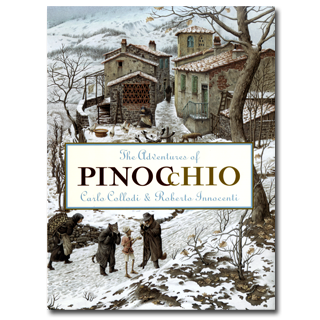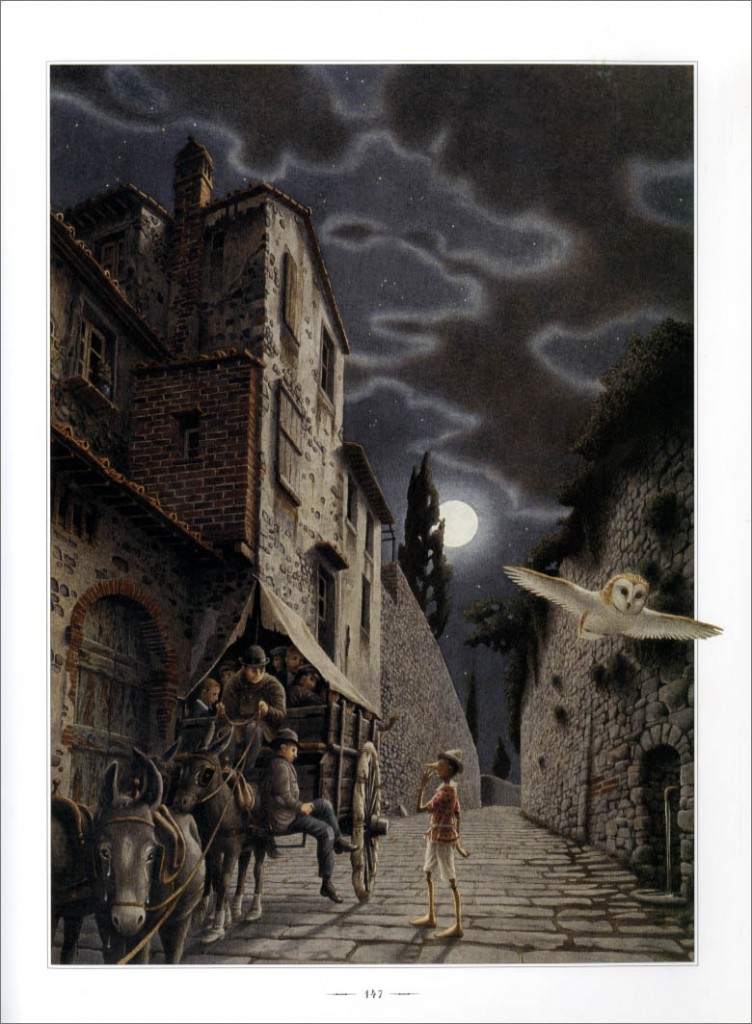
A FEW OTHER EVENTS FOR
FEBRUARY 7:
- Happy birthday Shonto Begay (The Mud Pony).
- It’s the birth date of Charles Dickens (1812–1870), A Christmas Carol and The Adventures of Oliver Twist, Fred Gipson (1908–1973), Old Yeller, and Laura Ingalls Wilder (1867–1957), Little House series.
- Blacksmith John Deere (1804–1886), founder of the tractor-making company, was born on this day. Read Katy and the Big Snow by Virginia Lee Burton and Otis by Loren Long.
- It’s Ballet Day. Read Ballerino Nate by Kimberly Bradley, illustrated by R.W. Alley, Dancing to Freedom: The True Story of Mao’s Last Dancer by Li Cunxin, illustrated by Anne Spudvilas, Josephine Wants to Dance by Jackie French, illustrated by Bruce Whately, and Angelina Ballerina by Katharine Holabird.
On February 7, 1940, RKO Radio Pictures released the second Walt Disney animated film, Pinocchio. As a child who fell under its spell, I remember many of its virtues—cutting edge animation, Academy Awards for the Best Original Score and Original Song, “When You Wish Upon a Star,” and the delightful Jiminy Cricket. Hence, imagine my surprise when I actually picked up Collodi’s The Adventures of Pinocchio twenty years later and discovered that the film and the book share a title but little else.
Initially, they were closer in conception, but Disney felt that no one could sympathize with Collodi’s anti-hero, the wooden puppet with sawdust for brains and a penchant for getting into trouble. Disney wanted a hero plus comic relief, and so Pinocchio’s sidekick Jiminy Cricket entered the script. If you have not read this book, one of the most frequently translated stories in the world, you will find some surprises here. I have no doubt that were this book to be submitted today to publishers in the United States, it would be summarily rejected. It breaks just about every “rule” and then some.
Pinocchio first appeared as a magazine serial and became a book in 1883. As Italian writer Umberto Eco has stated: “though it’s written in very simple language, Pinocchio is not a simple book.” Even as the toy marionette is being carved out of wood, he creates havoc in Master Cherry’s studio. After Geppetto brings the puppet back to his home, the long-suffering saint of a father gets nothing but grief for his pains. Pinocchio rambles on in long passages about how he will do better, and then off he goes on another evil escapade. Just like Curious George the monkey, Pinocchio delights young readers precisely because of the scrapes he manages to get into.
Collodi initially ended the story after Chapter 15, by hanging his puppet and killing him. The author had no intention of bringing this scamp back to life, but his editor begged him to write more. Hence the blue-haired fairy intercedes and resurrects Pinocchio; she also turns him, while dreaming, into a real boy at the end. As originally published, the puppet had no desire to become good—Collodi only added those elements as an afterthought. Even so Pinocchio remains a subversive character: When he can work, he plays; when he can do the right thing, he always does the wrong thing.
If you want to explore this classic and really understand it, the New York Review of Books provided an excellent translation by Geoffrey Brock with notes by Eco and Rebecca West. My favorite version for children remains the Creative Editions 2005 version of The Adventures of Pinocchio, with Roberto Innocenti’s dark and haunting illustrations. The master of unforgettable picture-book illustrations, Innocenti does not flinch away from the dark side of this story; he gives meaning and substance to Collodi’s sometimes disturbing text. For more information and art check out ReadAloud Dad.
What surprised me the most in rereading Pinocchio was how little time is spent on the idea of Pinocchio’s nose growing when he lies. That detail has haunted me from childhood—and probably made me a bit more truthful than I would be otherwise. But however you remember the story, you will be amazed when you actually pick it up in either of these excellent translations.
Here’s a page from Pinocchio:

Â
Originally posted February 7, 2011. Updated for 2024.













Hello Anita,
I split my sides reading the following sentence: “I have no doubt that were this book to be submitted today to publishers in the United States, it would be summarily rejected. It breaks just about every “rule” and then some.”
What a good observation! Makes one think about how really truly great things sometimes are great precisely because they do not fit the mold.
But – I am so so happy today.
Now Read Aloud Dad is forever part of Anita Silvey’s Book-A-Day Almanac! And not just any post. I’m referenced in your Carlo Collodi’s Pinocchio post. Wow.
To quote the mouse in My Father’s Dragon: “I must smell tumduddy. I mean, I must tell somebody!!” Thanks for this fantastic shoutout.
To all those who are still on the fence whether to read the original, let me quote Collodi (from the still above): “Come with us, and we’ll have such fun!”
Read Aloud Dad
Thanks both for your comment — and your research on the various editons of the book available in print.
Our classics, the books that last, always seem to ignore conventional wisdom.
We listened to an unabridged audiobook of Pinnochio many years ago, so I will be interested to check out this edition. Thanks for all your great book suggestions! Our family enjoyed The Race to Save the Lord God Bird that you featured some weeks back, and I was delighted to see you feature Maud Hart Lovelace, one of my favorite authors, last week.
I remember liking the book as a kid, but I liked a lot of old books, and enjoyed smirking over the didactic parts (I found a copy of Elsie, or Little by Little, for example). My biggest memory was the coach that lured Pinocchio away from school; he actually put up a few seconds of resistance there before falling into temptation.
I love Pinocchio. Of course the Disney version is always in my mind. But Colloddi original too. I read it because I love children books, the classics and others… My first impression was like yours Anita. So different from Disney. But the two versions are memorable.
Saw some tv films about it, but books like the one Roberto Inocenti illustrated are amazing. I have to check it out. I like others from Roberto and the details of the illustrations are great… the houses, the expressions…
I see the tears in the kid transformed as a donkey – nice touch – like in the Disney version, touch my heart.
I’m an illustrator too.
I only remember the Disney cartoon. Reading this, makes me want to take a look at the real story. I am also very interested in seeing the beautiful illustrations by Roberto after seeing the one example. Just breathtaking.
My daughter is taking Italian in school and they are reading Pinocchio in class. One night over dinner with a bunch of friends she was regaling us all with the real Pinocchio which none of her friends could believe. One of them even commented, “Are you sure you are translating that correctly?”
Hi — This is a great resource, keep up the hard work!
Just a note that Laura Ingalls Wilder’s death date is wrong, likely a typo!
Born: February 7, 1867
Pepin, Wisconsin
Died: February 10, 1957
Mansfield, Missouri
Thanks for catching this typo — correction made.
Hi – WOW. Pinocchio is one of my favorite stories. The Disney film too.
Yes Anita, they are really different. I can love both of them.
Different approaches on the story but Disney made it so good that when I read the original I hated.
But after some years I read it again and fell in love.
But still love Disney version too.
This book has the illustrations of the really great Roberto Innocenti. Love his work too.
Thanks for this critique of the Disney film and exploration of the real book. I had a battered old copy of the real book as a child so I feel lucky that I didn’t know the film first. Innocenti is an amazing illustrator.
I had the delightful experience of traveling to Florence last September and seeing Pinocchio dolls and puppets everywhere ! I had not realized Florence was the home of Pinocchio’s author. Our personal tour guide told me her children read and study the book in third grade. She agreed it was a tough story for them to read however it is part of the third grade curriculum and has been for a long time.
We then went to Venice where we found on a lonely alley, an old fashiioned printmaker. He uses old hand printers owning one of Benjamin Franklins’s in his shop. ( http://www.italymagazine.com/italy/arts-and-culture/gutenberg-venice-creates-celebrity-calling-cards-18th-century-machines) He also has designed a complete set of prints based on Pinocchio’s story. The cards are delightful and can be purchased individualy or as a complete set beautifully packaged. Of course I had to buy the complete set, especially after he told me Angelina Jolie had purchased one for her children! Actually I would have purchased them anyway as they are delightful.
I am so pleased you picked Pinocchio for your story today. I also grew up with the Disney version and whenever my children were lying I told them their noese were growing! I purchased an unabridged copy which I have been reading. I wonder if our schools would consider reading and studying the text as the children in Italy do! As a storyteller I do try to feed my listeners with the unbridged versions of fairy tales and other stories thatt Disney has Disneyfied as children and adults need to hear and understand the stories the way they were collected and told.